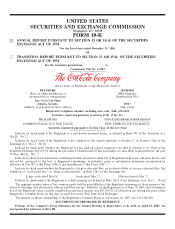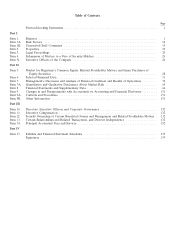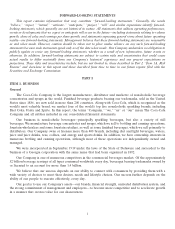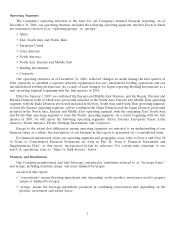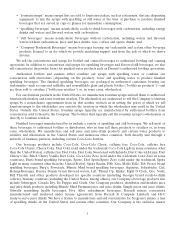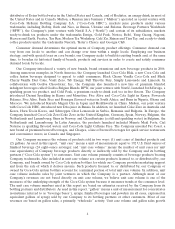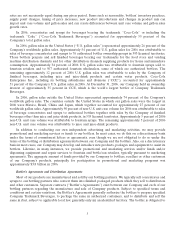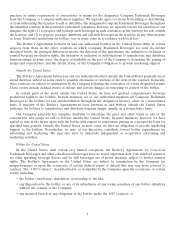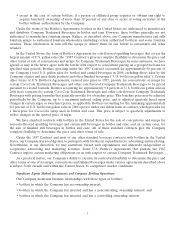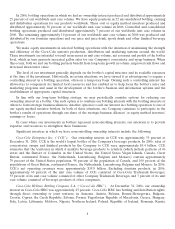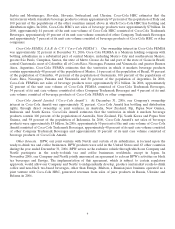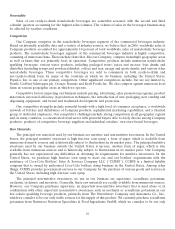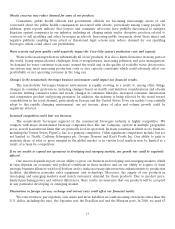Coca Cola 2006 Annual Report Download - page 7
Download and view the complete annual report
Please find page 7 of the 2006 Coca Cola annual report below. You can navigate through the pages in the report by either clicking on the pages listed below, or by using the keyword search tool below to find specific information within the annual report.rates are not necessarily equal during any given period. Items such as seasonality, bottlers’ inventory practices,
supply point changes, timing of price increases, new product introductions and changes in product mix can
impact unit case volume and gallon sales and can create differences between unit case volume and gallon sales
growth rates.
In 2006, concentrates and syrups for beverages bearing the trademark ‘‘Coca-Cola’’ or including the
trademark ‘‘Coke’’ (‘‘Coca-Cola Trademark Beverages’’) accounted for approximately 55 percent of the
Company’s total gallon sales.
In 2006, gallon sales in the United States (‘‘U.S. gallon sales’’) represented approximately 26 percent of the
Company’s worldwide gallon sales. Approximately 54 percent of U.S. gallon sales for 2006 was attributable to
sales of beverage concentrates and syrups to 76 authorized bottler ownership groups in 393 licensed territories.
Those bottlers prepare and sell finished beverages bearing our trademarks for the food store and vending
machine distribution channels and for other distribution channels supplying products for home and immediate
consumption. Approximately 34 percent of 2006 U.S. gallon sales was attributable to fountain syrups sold to
fountain retailers and to 507 authorized fountain wholesalers, some of which are authorized bottlers. The
remaining approximately 12 percent of 2006 U.S. gallon sales was attributable to sales by the Company of
finished beverages, including juice and juice-drink products and certain water products. Coca-Cola
Enterprises Inc., including its bottling subsidiaries and divisions (‘‘CCE’’), accounted for approximately
51 percent of the Company’s U.S. gallon sales in 2006. At December 31, 2006, our Company held an ownership
interest of approximately 35 percent in CCE, which is the world’s largest bottler of Company Trademark
Beverages.
In 2006, gallon sales outside the United States represented approximately 74 percent of the Company’s
worldwide gallon sales. The countries outside the United States in which our gallon sales were the largest in
2006 were Mexico, Brazil, China and Japan, which together accounted for approximately 27 percent of our
worldwide gallon sales. Approximately 90 percent of non-U.S. unit case volume for 2006 was attributable to sales
of beverage concentrates and syrups to authorized bottlers together with sales by the Company of finished
beverages other than juice and juice-drink products, in 535 licensed territories. Approximately 5 percent of 2006
non-U.S. unit case volume was attributable to fountain syrups. The remaining approximately 5 percent of 2006
non-U.S. unit case volume was attributable to juice and juice-drink products.
In addition to conducting our own independent advertising and marketing activities, we may provide
promotional and marketing services or funds to our bottlers. In most cases, we do this on a discretionary basis
under the terms of commitment letters or agreements, even though we are not obligated to do so under the
terms of the bottling or distribution agreements between our Company and the bottlers. Also, on a discretionary
basis in most cases, our Company may develop and introduce new products, packages and equipment to assist its
bottlers. Likewise, in many instances, we provide promotional and marketing services and/or funds and/or
dispensing equipment and repair services to fountain and bottle/can retailers, typically pursuant to marketing
agreements. The aggregate amount of funds provided by our Company to bottlers, resellers or other customers
of our Company’s products, principally for participation in promotional and marketing programs was
approximately $3.8 billion in 2006.
Bottler’s Agreements and Distribution Agreements
Most of our products are manufactured and sold by our bottling partners. We typically sell concentrates and
syrups to our bottling partners who convert them into finished packaged products which they sell to distributors
and other customers. Separate contracts (‘‘Bottler’s Agreements’’) exist between our Company and each of our
bottling partners regarding the manufacture and sale of Company products. Subject to specified terms and
conditions and certain variations, the Bottler’s Agreements generally authorize the bottlers to prepare specified
Company Trademark Beverages, to package the same in authorized containers, and to distribute and sell the
same in (but, subject to applicable local law, generally only in) an identified territory. The bottler is obligated to
5

